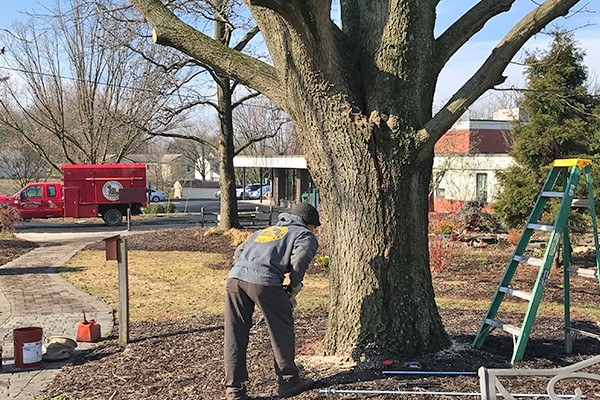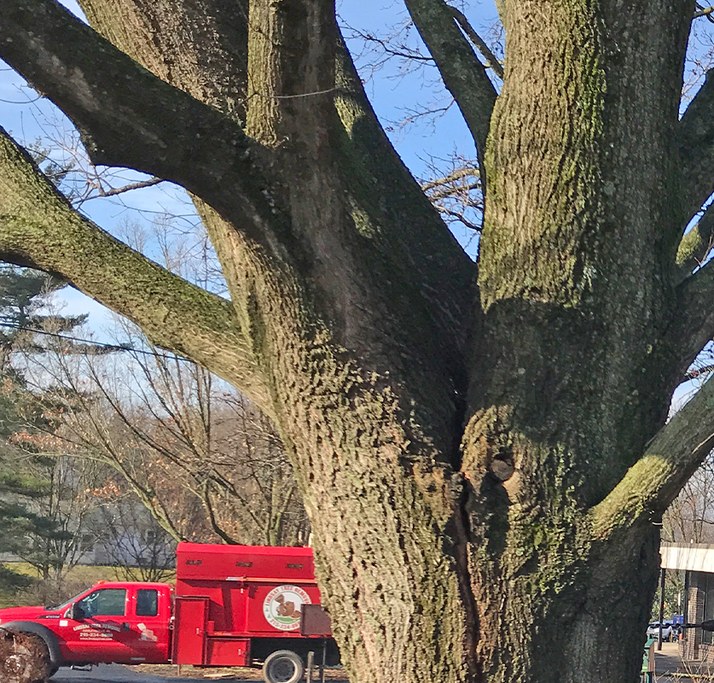Pruning, the selective removal of specific branches or stems, is an important maintenance practice that helps to keep trees healthy and can prevent serious, and costly, issues in the future.

A certified arborist examines the oak tree. Photo: Virginia Cunningham, Penn State
One such issue involves the development of more than one dominant leader. Ideally, there should be a single dominant stem, the tallest, strongest, main branch of the tree. This leader should not be pruned back nor should secondary branches be allowed to outgrow the leader. If a tree has co-dominant stems (known as double leaders), one should be removed to avoid structural weakness. Competing branches should be prevented from growing larger than half the trunk diameter by removing them or bending them downward to slow their growth.
Another issue involves the angle formed between two branches, called the crotch. Sometimes branches develop with narrow, vee-shaped angles of attachment, that is, with tight crotches. As the tree grows, the bark becomes enclosed within the crotch, which leads to weakness and branch failure or dieback. Branches with narrow crotches should be removed or stretched to a wider angle when the tree is young.
But what happens if these recommended practices are not done at the proper time? One example occurred in a venerable oak tree in the Hosta Garden of the Master Gardener Demonstration and Learning Gardens in Collegeville. The oak was allowed to develop not only with two dominant leaders but with a narrow, vee-shaped crotch.

Figure 1. In this photo, you can clearly see the two dominant leaders and the narrow, vee-shaped crotch. Photo: Virginia Cunningham, Penn State
In recent years, this now quite mature tree has run into a serious situation. As the tree grew, the two dominant leaders in a narrow vee fused together, and a long, and deep, crack developed through the trunk. There was real concern that a storm could cause the whole tree to split in half, possibly leading to serious injury and/or property damage, as well as destroying a valuable aspect of the Gardens.
To address this problem, we consulted with a certified arborist from Lindsay Tree Removal Company, who recommended that the tree be pruned to lighten the canopy, cabled to support key branches, and stabilized through the trunk with steel bars.

Figure 2. Pruning to lighten the canopy. Photo: Virginia Cunningham, Penn State

Figure 3. The tree was cabled (red arrows) to support key branches. Photo: Virginia Cunningham, Penn State

Figure 4. Steel bars are inserted through the trunk and capped with a nut. Photo: Virginia Cunningham, Penn State
The pruning and cabling work was done in mid-winter, and the stabilization was completed on March 10, 2022. After carefully selecting the best locations, holes were drilled through the tree trunk in two areas with different orientations. Metal bars were driven through, and the ends of each bar were capped with a nut. You can see the final results when next you visit the gardens.
Given the premier status of oaks for ecological benefit, we hope our oak will contribute for years to come. We will carefully monitor the situation, check on stability, and make sure the tree continues to prosper, add beauty and welcome shade, and serve as a vital component of the food chain. Among other contributions, oak trees support more caterpillar species than any other plant, and innumerable animals feed on acorns. They are a treasure worth preserving.
Author: Virginia Cunningham, Penn State Master Gardener

